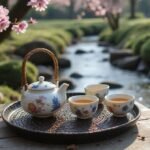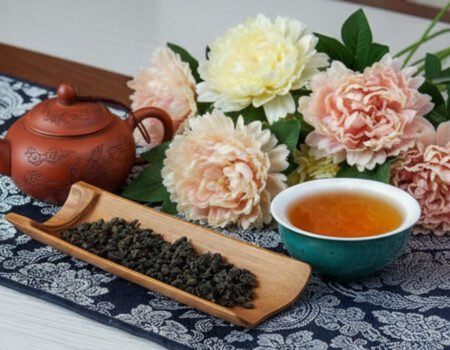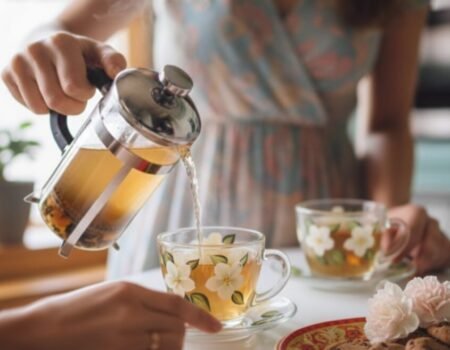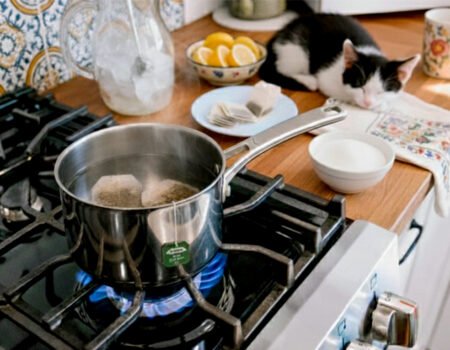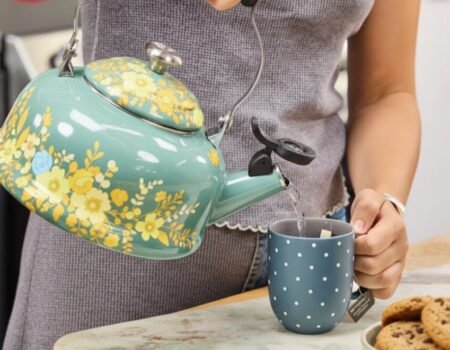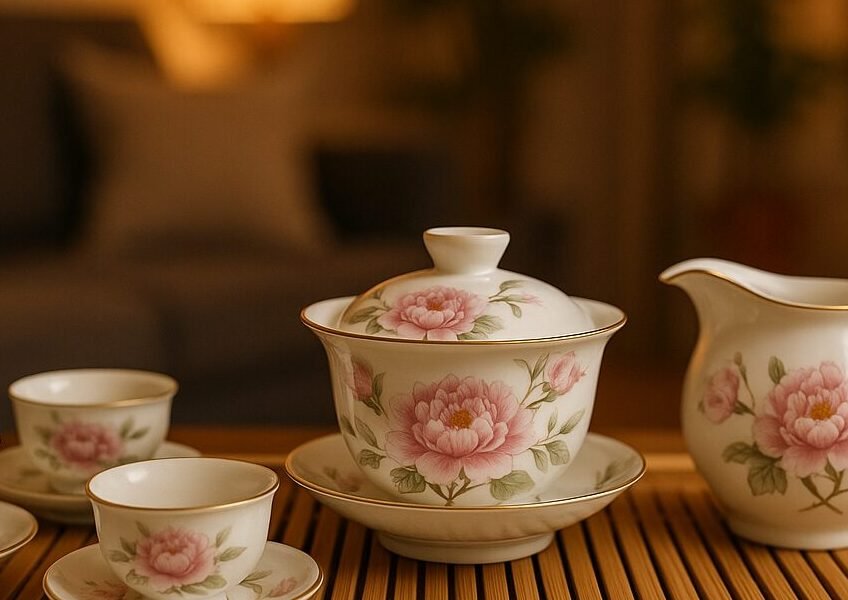
Discover the Best Gaiwans for Your Tea Ritual
Index
Index
Finding the right brewing vessel can make or break your tea experience. Gaiwans have been central to Chinese tea culture for centuries, serving as both practical tools and symbols of tradition.
This guide will help you select the perfect gaiwan that matches your brewing style and enhances your tea’s flavors. Get ready to transform your daily tea ritual.
Key Takeaways
- Gaiwans consist of three parts (lid, bowl, and saucer) that work together to create the perfect tea brewing vessel.
- Material choice impacts flavor – porcelain gaiwans offer neutrality ideal for tasting, while clay versions enhance specific tea types.
- The gaiwan serves as the central tool in Gongfu Cha ceremonies, allowing precise control over brewing temperature and steeping time.
- Proper handling techniques involve a three-finger grip and tilting the lid to strain leaves while pouring.
- Different teas require specific brewing approaches – green teas need lower temperatures and brief steeps, while pu-erhs pair well with clay gaiwans that enhance their earthy depth.
Understanding the Gaiwan: Components and Significance
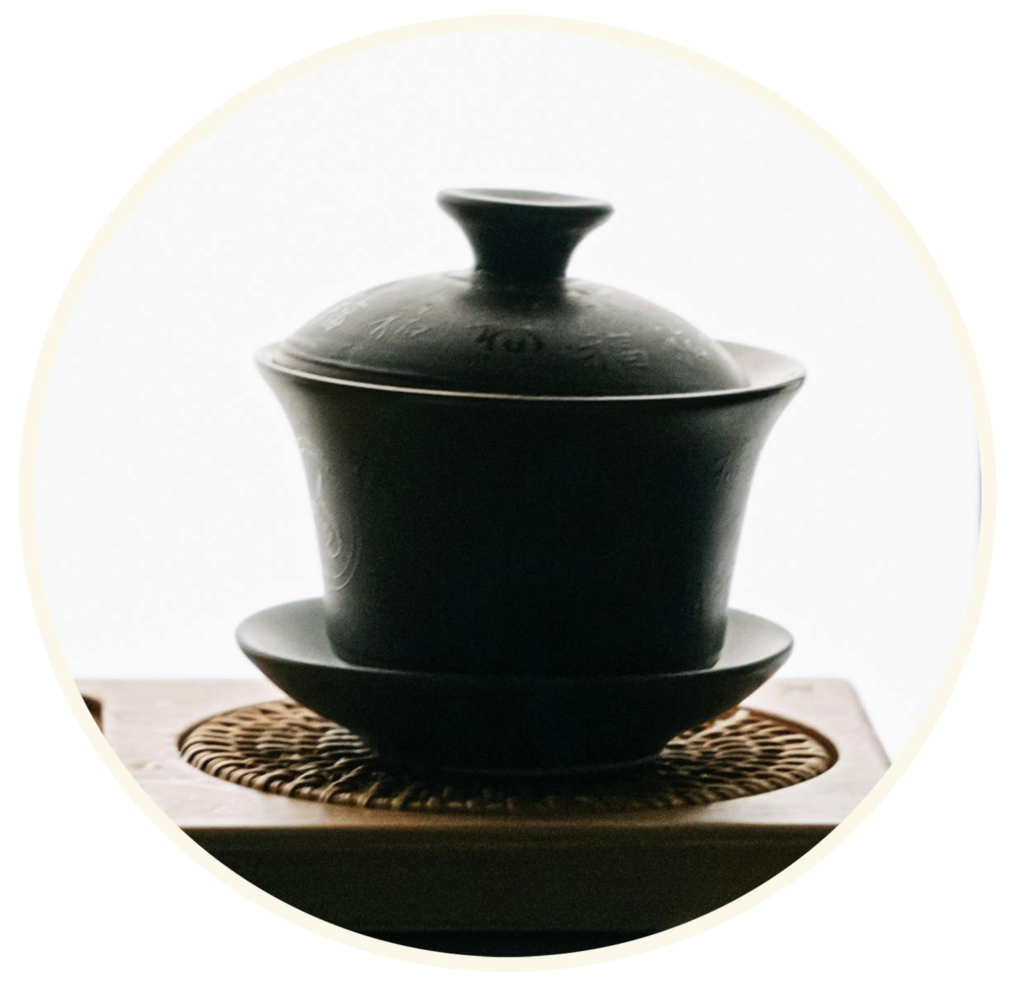
A gaiwan combines three key parts – a lid, bowl, and saucer – that work together to create the perfect tea brewing vessel. Each material choice, from delicate porcelain to sturdy clay, shapes your tea’s flavor profile and connects you to centuries of Chinese tea tradition.
Defining the Three Parts: Lid, Bowl, and Saucer
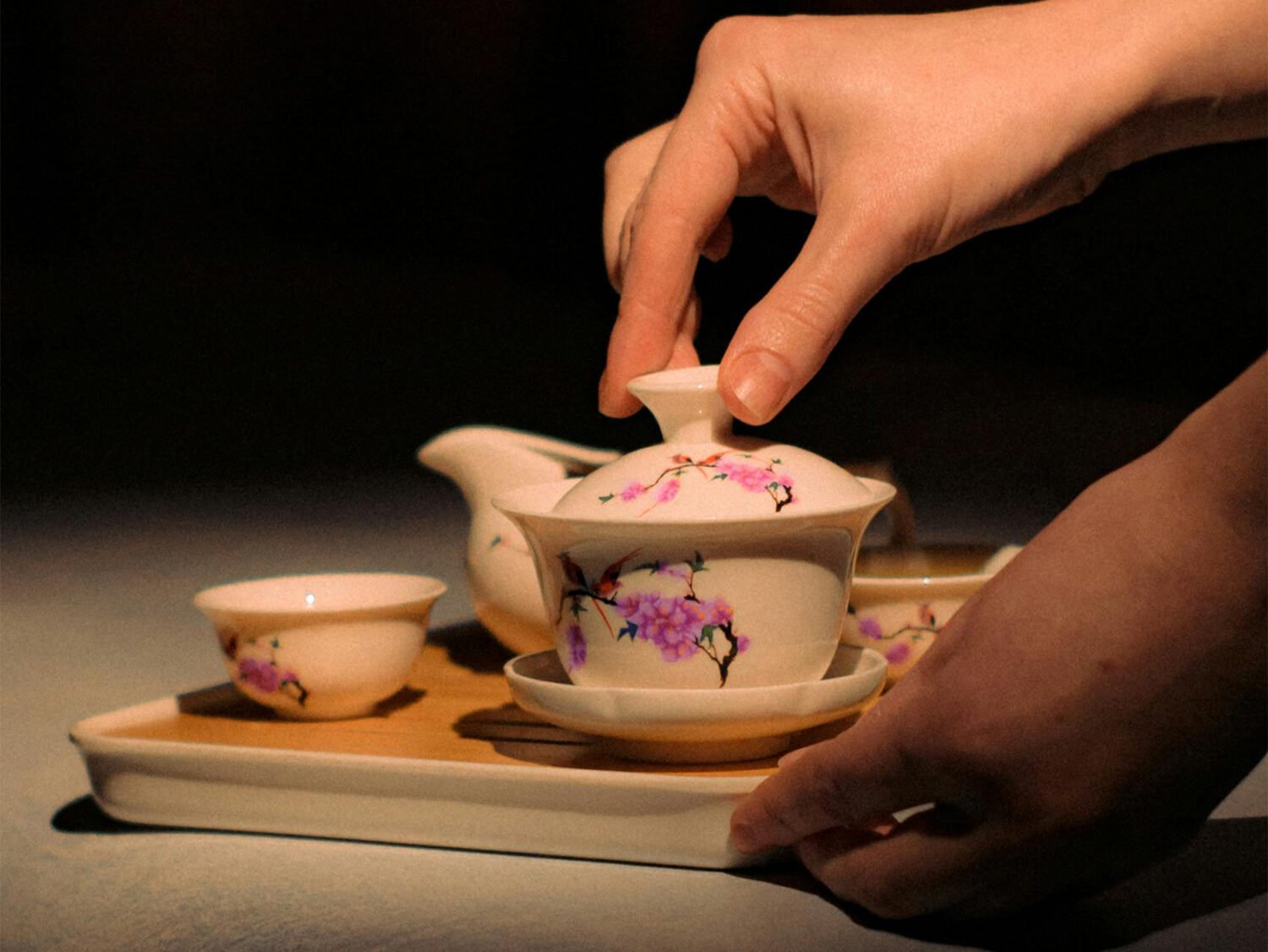
A traditional gaiwan features three distinct parts that work together for perfect tea brewing. The lid serves as more than just a cover – it traps heat inside the vessel and enhances flavor development during steeping.
Tea lovers use the lid to control brewing time and strain leaves when pouring. The bowl holds your tea leaves and water, allowing them to mingle and release their flavors. Made from porcelain, celadon, or other materials, this central component showcases the unfurling leaves during infusion.
The saucer provides a stable base for the bowl and catches any drips that might occur during pouring, keeping your tea ritual neat and organized. Each component plays a vital role in both function and beauty during gongfu cha sessions.
The materials used to craft these three elements significantly impact your brewing experience and the resulting tea flavors. Porcelain gaiwans from Jingdezhen offer excellent heat retention with neutral flavor profiles, while celadon versions add subtle mineral notes to delicate white teas.
Some artisans create stunning hand-painted designs on these vessels, transforming them into works of art that honor tea’s rich cultural heritage. The relationship between these three parts creates the perfect balance of form and function that has made the gaiwan essential in Chinese tea culture since the Ming Dynasty.
The materials used for gaiwans directly influence how your tea will taste and feel.
Materials and Their Impact on Brewing
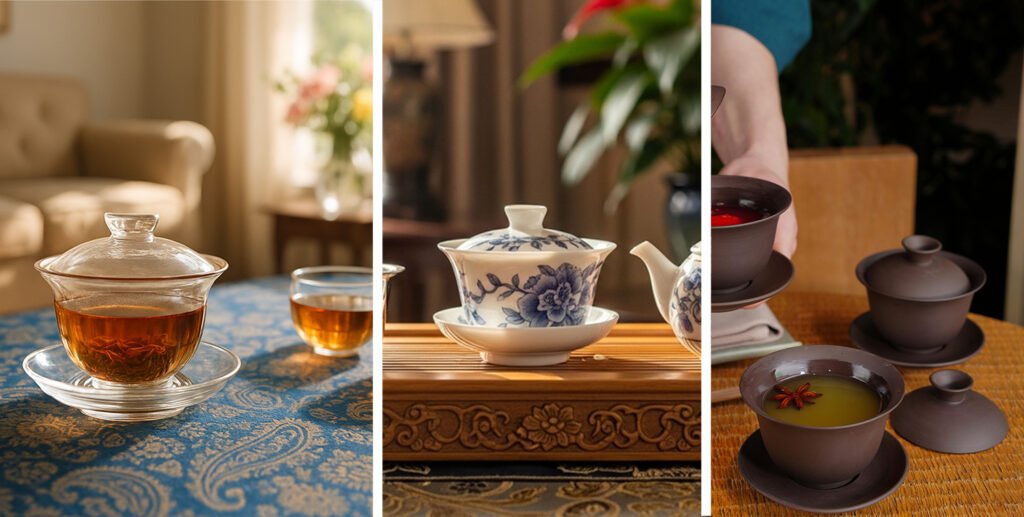
Gaiwans come in several materials that directly affect your tea experience. Glazed ceramic, porcelain and glass gaiwans offer neutral brewing vessels that won’t alter your tea’s natural flavor profile.
These materials showcase the true character of delicate green teas and light oolongs without adding unwanted notes. Porcelain from Jingdezhen stands out for its thin walls that retain heat well while allowing you to observe the tea’s color.
Clay gaiwans require more commitment as they need proper seasoning and work best with specific tea types. Yixing clay absorbs tea oils over time, enhancing flavor extraction with each use.
Jian Shui clay gaiwans feature excellent heat retention that brings out deep aromatics in darker teas like puerh. The material you select impacts both the practical brewing aspects and the aesthetic appeal of your tea ritual.
High-quality craftsmanship in any material will elevate your tea’s natural scents and tastes during the brewing process.
Symbolic Meaning in Chinese Tea Culture
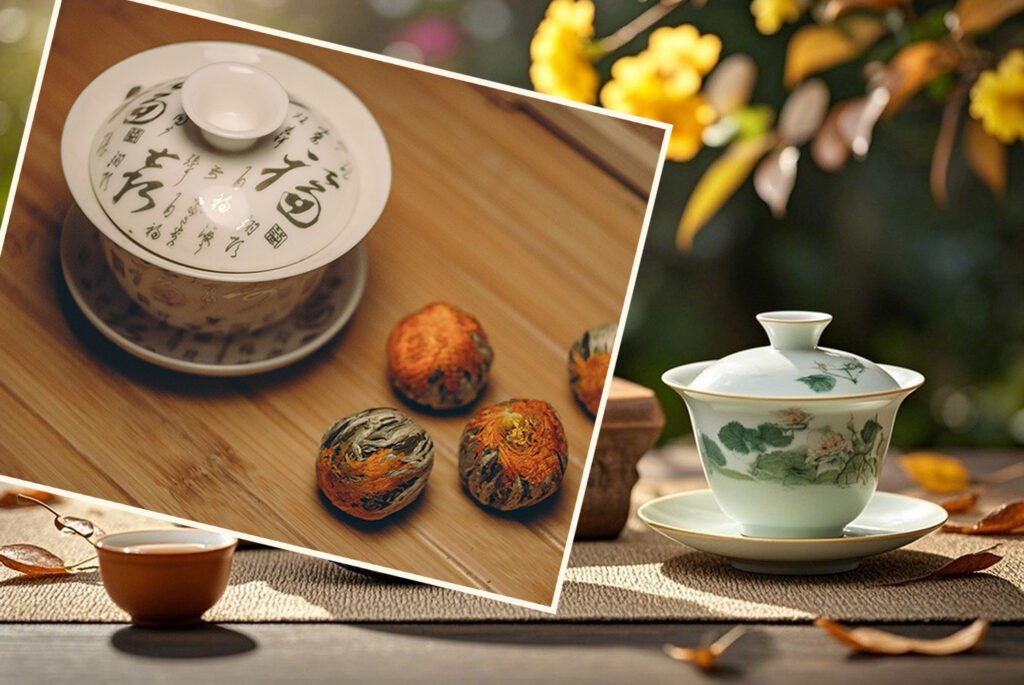
The gaiwan stands as a powerful symbol in Chinese tea traditions, representing the deep connection between people and their cultural roots. This simple vessel combines beauty and function through its three-part design, reflecting centuries of artistic development during the Qing dynasty.
Tea ceremonies using gaiwans invite participants to slow down and practice mindfulness with each pour. Many tea enthusiasts value these vessels not just for brewing but as links to tea farmers who maintain traditional growing methods in regions like Fujian and Yunnan.
The designs found on porcelain gaiwans often tell stories through blue and white pottery patterns or hand-painted scenes that carry specific cultural meanings. A white jingdezhen porcelain gaiwan might showcase natural motifs that honor the relationship between humans and nature.
The ritual of brewing with a gaiwan teaches respect for both the tea leaves and the ceremony itself. This respect extends to appreciating how different materials affect the brewing process, which leads us to explore various gaiwan compositions and their unique properties.
Key Characteristics and Advantages of Using a Gaiwan
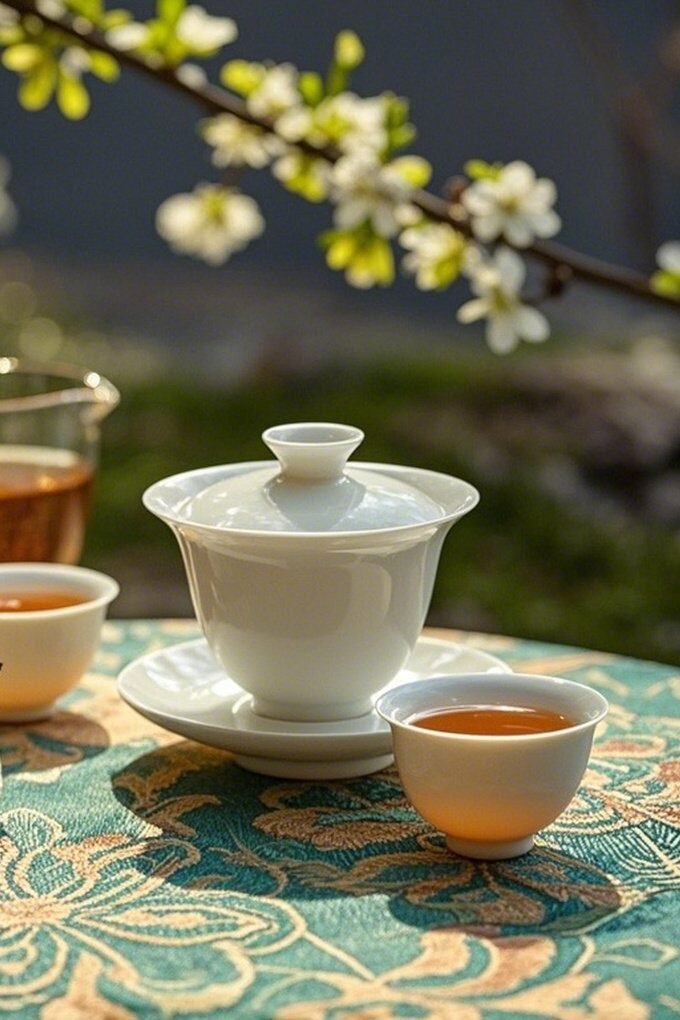
A gaiwan offers tea lovers unique benefits that enhance the brewing experience. Its simple design allows you to see, smell, and taste your tea with greater clarity than most brewing vessels.
Flavor Neutrality for True Tea Appreciation
Gaiwans offer exceptional flavor neutrality that lets you taste tea in its purest form. Unlike Yixing teapots that absorb flavors over time, white porcelain gaiwans remain neutral vessels that won’t alter your tea’s natural profile.
This quality makes them perfect for tea tasting sessions where detecting subtle notes matters most. Many tea experts prefer porcelain gaiwans specifically because they allow the true characteristics of fine tea to shine through without interference.
The material of your gaiwan plays a crucial role in maintaining this neutrality. High-firing temperatures used in creating porcelain and glass gaiwans result in non-porous surfaces that don’t retain odors or flavors between brews.
This makes switching between different tea types—from delicate white teas to robust oolongs—simple and effective. You’ll notice how camellia sinensis leaves express their authentic flavor profiles more clearly in a neutral gaiwan than in other brewing vessels.
Versatility Across Different Tea Types
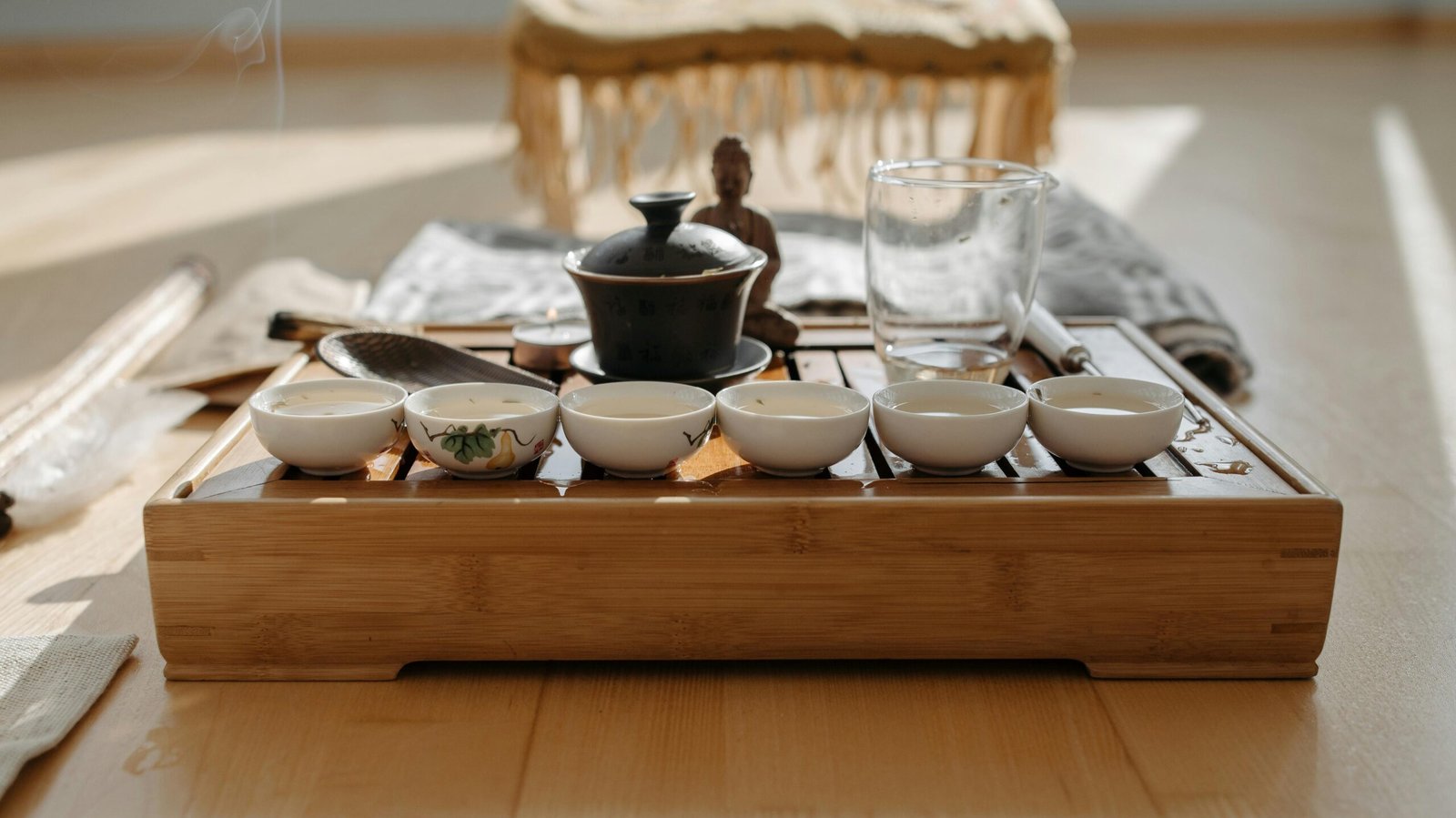
Gaiwans shine as true all-purpose brewing vessels in the tea world. Glazed ceramic and porcelain options work beautifully with every tea variety from delicate white teas to robust pu-erhs.
These materials stay neutral, letting each tea express its true character without unwanted flavor interference. For tea lovers seeking deeper exploration, specialized Yixing clay gaiwans pair perfectly with specific tea types, enhancing their natural qualities through the clay’s unique properties.
The gaiwan’s simple yet effective design makes it ideal for gong fu style brewing across the tea spectrum. Its wide opening allows tea leaves to unfurl completely, while the lid controls steeping time with precision.
Many tea drinkers appreciate how a single white porcelain gaiwan can transition seamlessly between green tea in the morning and oolong in the afternoon. This adaptability makes the gaiwan an essential tool for both casual sipping and serious tea study sessions.
Enhanced Control: Leaf Observation, Heat, and Pouring
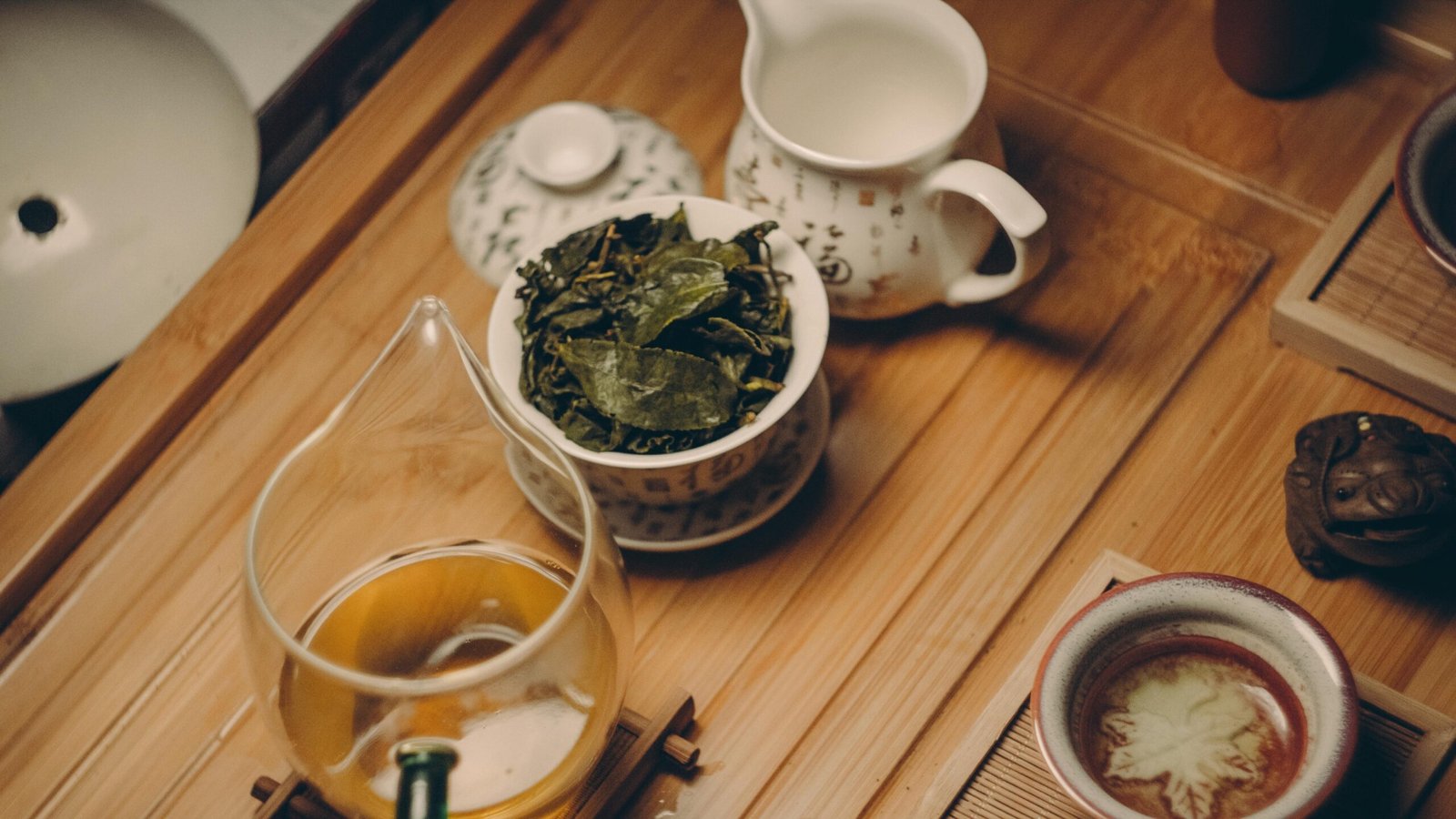
Beyond their adaptability with different teas, gaiwans offer tea lovers superior control during brewing. The wide opening and shallow bowl design let you watch tea leaves unfold and dance in the water, revealing clues about quality and proper steeping time.
This direct visual access helps you judge when your tea has reached peak flavor, unlike common teapots that hide the brewing process.
The lid serves as both temperature regulator and strainer, giving you precise command over heat retention. You can adjust how much steam escapes by positioning the lid, directly affecting brewing temperature.
The gaiwan’s design also enables clean, directed pouring – a crucial skill that impacts flavor extraction. Many tea enthusiasts appreciate how this simple tool transforms brewing from guesswork into an art form with measurable results.
The Gaiwan in Gongfu Cha
The gaiwan stands as the heart of Gongfu Cha, where its thin walls and wide opening create the perfect environment for leaves to unfold and release their full character – stay with us to learn how this simple vessel transforms tea brewing into an art form.
Role as a Primary Brewing Vessel
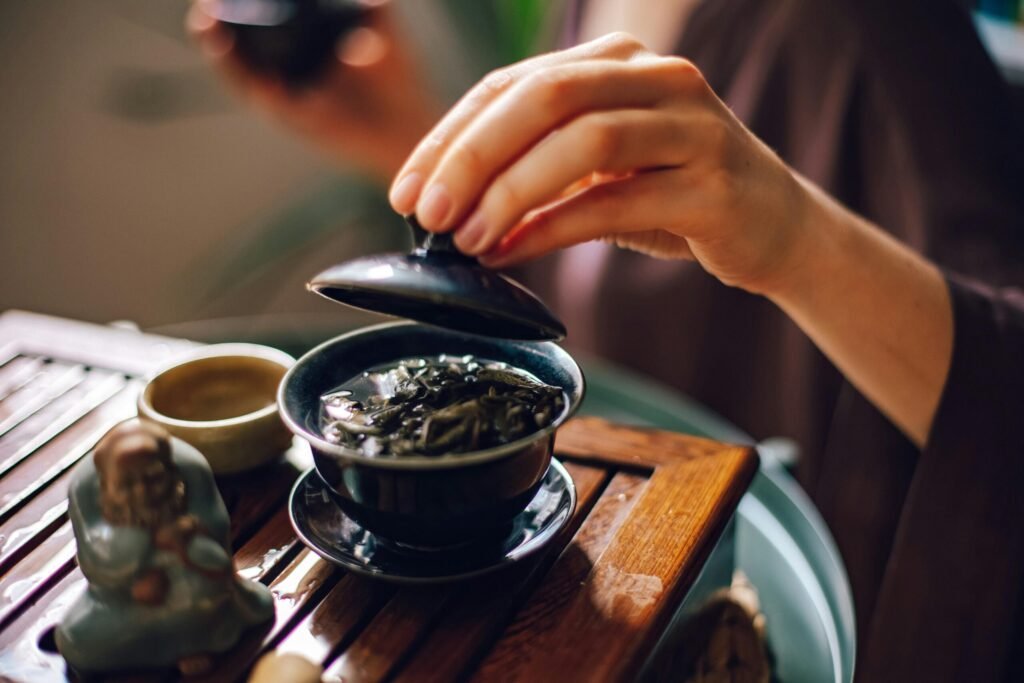
In Gongfu Cha ceremonies, the gaiwan serves as the central brewing vessel where tea transformation happens. This lidded bowl controls every aspect of the brewing process, from leaf expansion to temperature regulation.
Tea masters prize gaiwans for their ability to showcase a tea’s true character without adding unwanted flavors. Porcelain gaiwans remain neutral while clay versions can enhance specific tea types through seasoning.
Gaiwans excel at brewing delicate white teas, complex oolongs, and full-bodied pu-erhs with equal skill. Their wide opening allows easy leaf observation, while the lid serves multiple functions: heat retention, infusion control, and straining leaves during pouring.
This versatility makes the gaiwan essential in traditional Chinese tea culture, where it has been used since the Song dynasty to extract optimal flavor from premium teas.
Interaction with the Fairness Pitcher
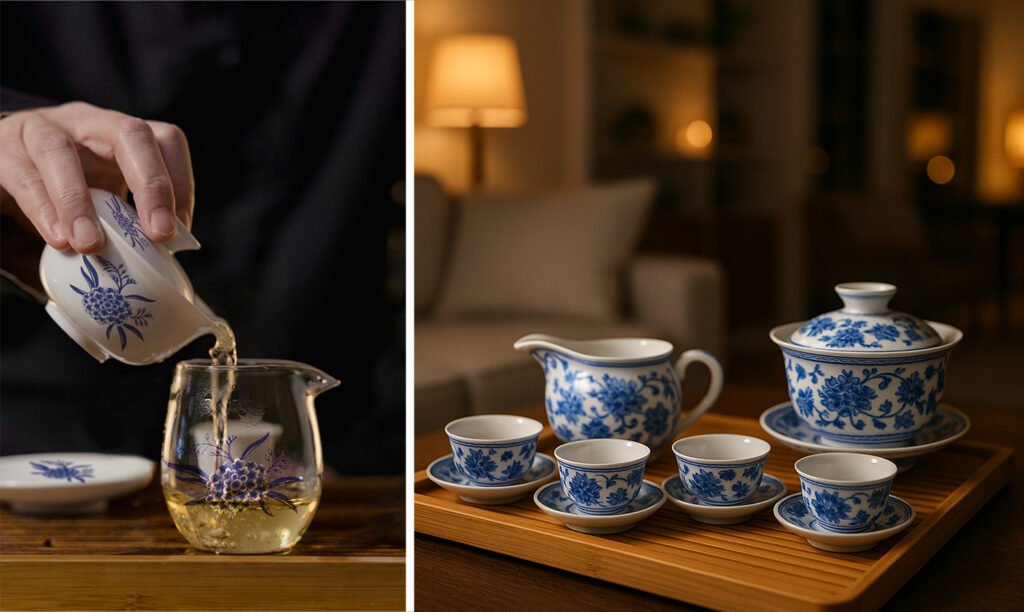
The fairness pitcher plays a vital role in Gongfu tea ceremonies alongside your gaiwan. After brewing tea in your porcelain or celadon gaiwan, you pour the liquid into this pitcher before serving.
This step ensures each cup receives tea of the same strength and flavor profile. The gaiwan and fairness pitcher work as partners – one extracts the tea’s essence while the other distributes it fairly.
Many tea enthusiasts choose matching sets where the glazed porcelain gaiwan complements their pitcher in style and material.
Tea masters value this interaction because it adds both function and beauty to the ritual. The fairness pitcher prevents the last cup from being too strong or bitter, a common problem with direct gaiwan-to-cup pouring.
During tea preparation, you’ll notice how this pairing creates a rhythm to your movements. The transfer from brewing vessel to pitcher gives you a moment to appreciate the tea’s color and aroma before sharing it with guests.
This practical step shows respect for both the tea itself and those you serve.
Techniques for Aroma and Flavor Extraction
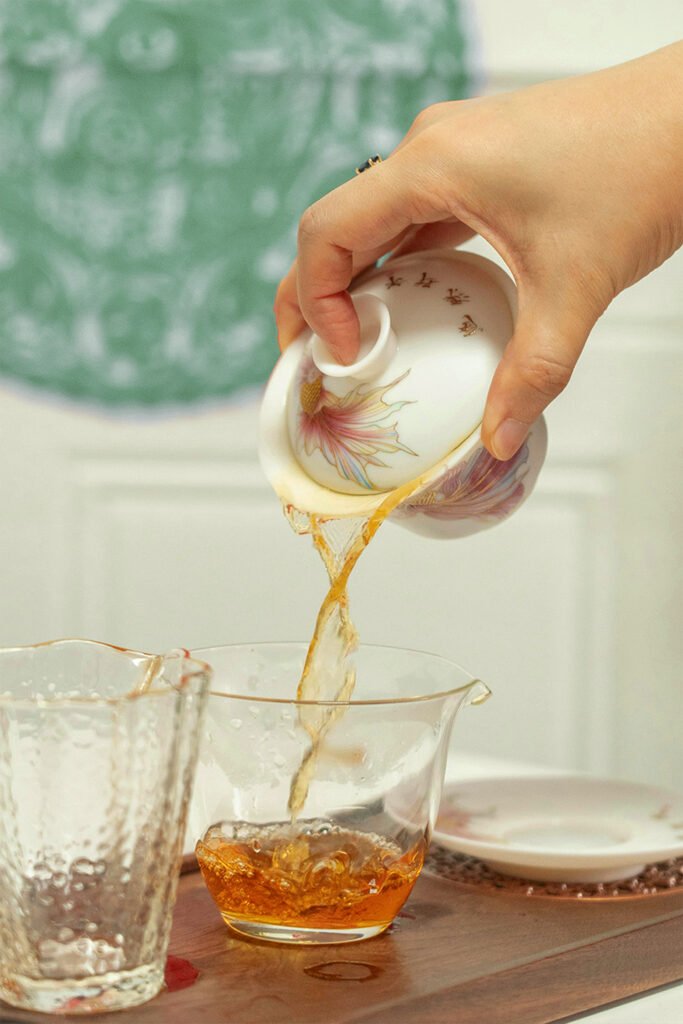
Gaiwan brewing unlocks the full potential of your tea leaves through specific methods. These techniques help you capture every nuance of flavor and aroma that quality tea offers.
Essential Temperature & Heating Techniques
- Pre-warm your gaiwan – Rinse with hot water before adding tea leaves. This simple step creates the perfect environment for leaves to unfurl and release their full flavor potential.
- Master water temperatures – Green teas thrive at 175°F (79°C) while black teas need 205°F (96°C) to perform their best. The right temperature unlocks each tea’s unique character.
- Use circular pouring – When adding water, pour in a gentle circular motion. This technique distributes heat evenly throughout the leaves for consistent extraction.
- Control brewing speed with lid gaps – Position the gaiwan lid to create different-sized openings. Smaller gaps slow brewing and retain more heat, while larger gaps speed up the process.
Brewing & Pouring Methods
- Perfect the flash infusion – Quick 5-10 second steeps allow multiple infusions from the same leaves. You’ll discover new flavor profiles with each pour.
- Master the 45-degree tilt – Angle your gaiwan when pouring to keep leaves inside while liquid flows smoothly into cups or a fairness pitcher.
- Adjust your leaf ratio – Start with a 1:20 tea-to-water ratio. The small brewing vessel concentrates flavors beautifully when proportions are right.
- Choose porcelain for pure flavor – Porcelain gaiwans showcase tea’s true character without adding outside influences, making them ideal for tasting sessions.
Sensory Experience & Observation
- Trap aromas with the lid – Keep aromatic compounds inside the bowl during brewing. This intensifies the tea experience with each infusion.
- Appreciate aromas between steeps – Take a moment to smell both the empty gaiwan and the underside of the lid. You’ll detect subtle changes as the session progresses.
- Watch the leaves expand – Mindful observation of leaf unfurling provides visual cues about extraction progress and helps you determine optimal steep times.
- Maintain your gaiwan properly – Clean thoroughly between different tea sessions to prevent flavor contamination and ensure each tea shines on its own.
Next, we’ll explore how gaiwans serve as essential tools for tea exploration and development for both beginners and seasoned tea enthusiasts.
Brewing with a Gaiwan: A Practical Guide
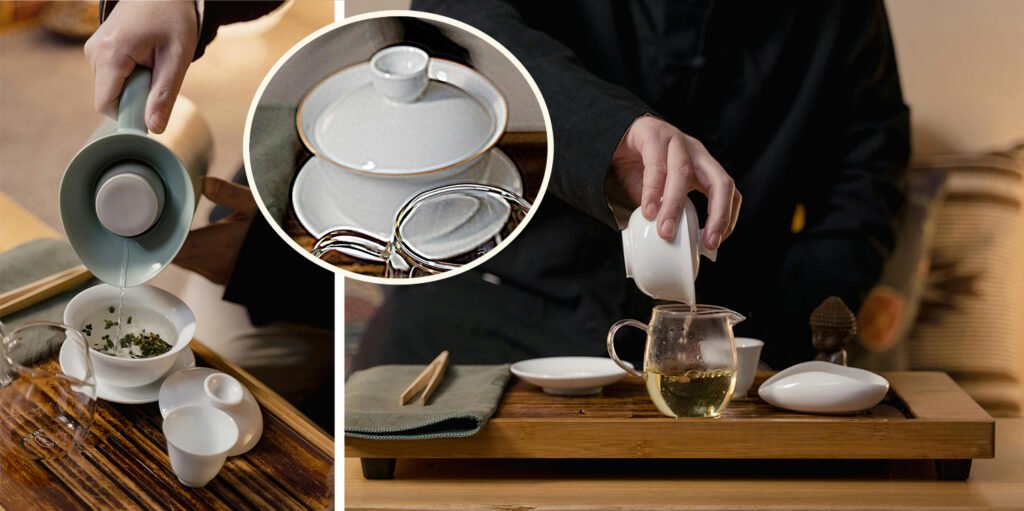
Brewing with a gaiwan takes practice, but yields rich rewards for tea lovers willing to master this classic method. The simple steps of warming, adding leaves, and pouring create a ritual that brings out the best flavors from your favorite teas.
Essential Steps for Gongfu Style Brewing
Gongfu brewing brings out the best flavors in your tea through precise methods and careful attention. The right gaiwan serves as your key tool in this traditional Chinese approach to tea preparation.
Gaiwan Selection & Preparation
- Choose quality materials – Select porcelain or glazed ceramic gaiwans for versatility across most tea types. Clay gaiwans excel with specific teas but need proper seasoning before first use.
- Pre-warm the vessel – Fill your gaiwan with hot water and let it sit for a few seconds before discarding. This crucial step maintains optimal brewing temperature throughout your session.
- Measure your leaves – Add 5-8 grams of tea to your warmed 120ml gaiwan. You’ll adjust this ratio based on tea type and personal preference as you gain experience.
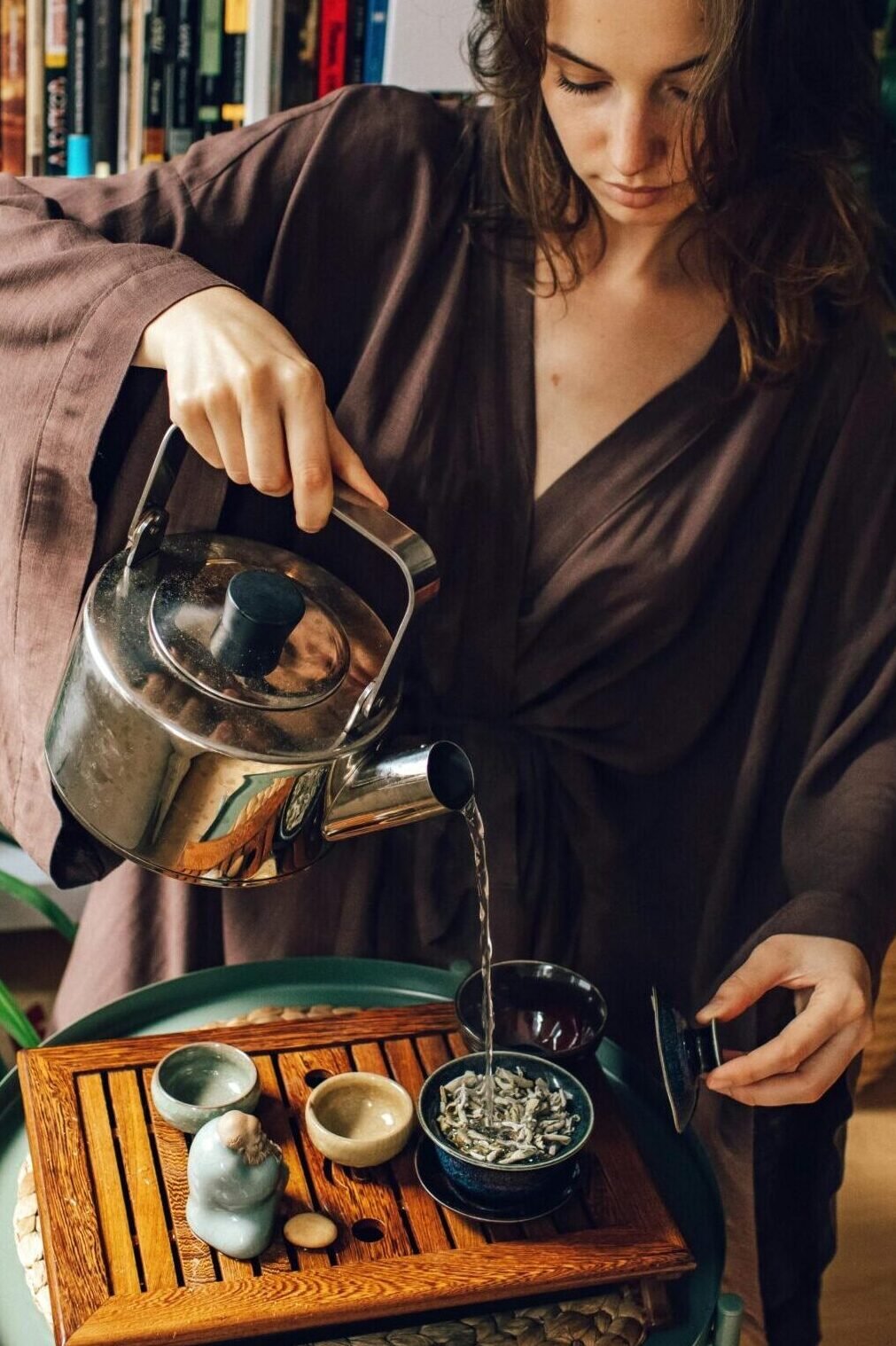
The Brewing Process
- Control water temperature – Pour water at the precise temperature your tea requires, filling about three-quarters full. Green teas thrive at lower temperatures while darker teas need more heat.
- Time your steeps carefully – Place the lid and steep for 15-30 seconds for green teas or 45-60 seconds for darker varieties. These initial times create your baseline for subsequent infusions.
- Watch the leaves transform – Observe how tea leaves unfold with each brewing cycle. This visual assessment reveals tea quality and helps you fine-tune brewing parameters.
Mastering the Pour
- Perfect your grip – Hold the gaiwan with thumb and middle finger on the rim, index finger controlling the lid. This three-point grip prevents burns while maintaining steady control.
- Create the ideal gap – Tilt the lid slightly to form a small opening that strains tea while keeping leaves inside. The gap size controls pour speed and filtration.
- Ensure even distribution – Pour directly into cups for intimate sessions or use a fairness pitcher when serving multiple people. Either method delivers consistent flavor to every cup.
Multiple Infusions
- Extend your session – Re-steep the same leaves multiple times, gradually increasing steep time with each round.
- Quality leaves reward patience with evolving flavor profiles across 5-8 infusions or more.
Mastering Gaiwan Grips and Pouring Techniques
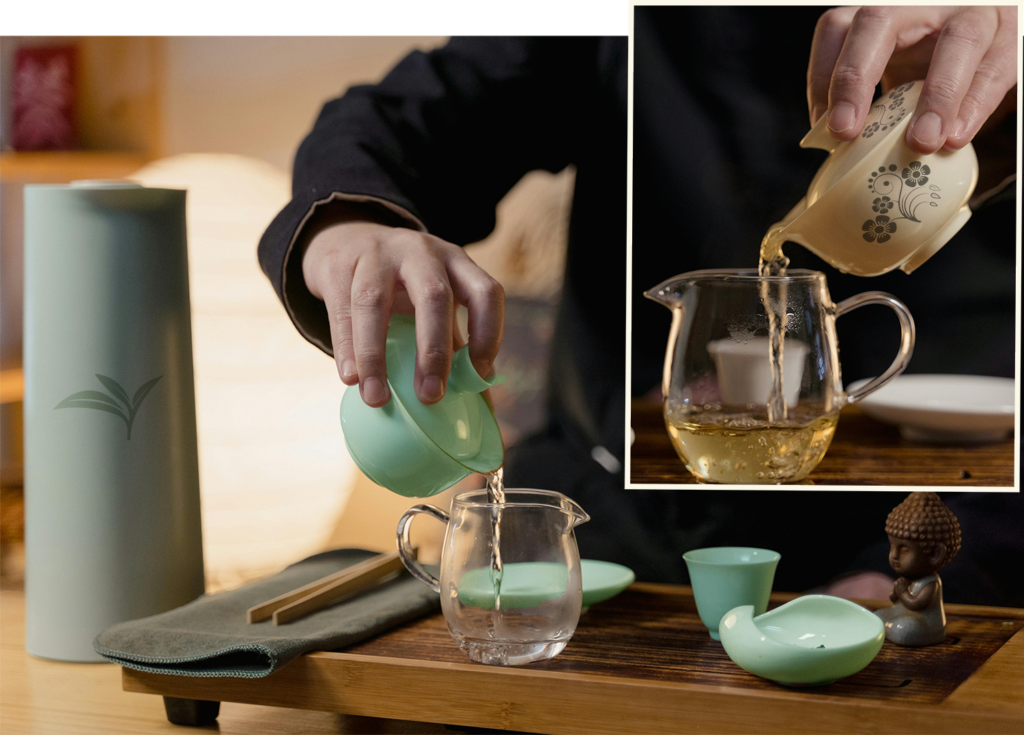
Proper handling of your gaiwan makes all the difference in your tea brewing success. These techniques take practice but will soon become second nature as you develop your tea ritual skills.
Essential Grip Techniques
- Master the three-finger grip – Place your thumb on the lid’s knob, index finger on the rim, and middle finger supporting the bottom edge. This foundational hold works perfectly for most tea sessions.
- Try the “claw” hold for hotter teas – Pinch the lid between thumb and middle finger while your index finger rests on top. This grip keeps your fingers farther from the hot porcelain.
- Build muscle memory safely – Practice your grip with an empty gaiwan before adding hot water. You’ll develop confidence without risk of spills or burns.
- Start with the saucer – Beginners can grip the saucer separately while learning to coordinate bowl and lid movements. Graduate to the full technique as comfort increases.
Pouring Control & Mechanics
- Create the perfect gap – Tilt the lid slightly away from you to form an opening that strains tea while keeping leaves inside. Smaller gaps work for fine leaves, wider gaps for larger ones.
- Pour with steady confidence – Maintain consistent pressure on both lid and bowl for a smooth, controlled stream. Your grip pressure directly affects flow rate.
- Fine-tune your flow – Apply firmer finger pressure for slower, more controlled pours. Lighten your touch when you want a faster stream into cups or pitcher.
- Position your tea boat strategically – Place your tray directly below the gaiwan to catch any drips. This setup keeps your tea table clean during the entire session.

Temperature & Material Considerations
- Start cooler while learning – Use 175°F (79°C) water when first handling a gaiwan since porcelain conducts heat quickly. You’ll avoid burns while perfecting your technique.
- Adjust for different materials – Porcelain gaiwans transfer more heat than stoneware versions. Modify your grip and timing based on what you’re using.
Advanced Techniques for Better Tea
- Use a fairness pitcher – Pour from your gaiwan into this intermediate vessel to ensure every guest receives tea with identical flavor concentration.
- Rotate during brewing – Turn the gaiwan slightly while steeping to encourage even extraction from all leaves. This subtle movement improves consistency.
- Read the lid aromas – Lift the lid briefly between steeps and inhale deeply. You’ll detect how the tea’s character evolves through multiple infusions.
- Perfect the sniffing cup method – Pour into small aroma cups first to capture different scent profiles at various temperatures. This technique reveals hidden complexity in premium teas.
Adapting Gaiwan Use for Various Tea Categories

Different teas demand specific brewing approaches to reveal their best qualities. A classic gaiwan offers remarkable flexibility across tea types, but small adjustments can dramatically improve your results.
Delicate Teas: Green, White & Yellow
- Green teas in white porcelain – Lower temperatures work best in white porcelain gaiwans. Fill your vessel only one-third full and keep steep times brief (15-30 seconds) to prevent any bitterness from developing.
- White teas need gentle handling – Choose thin porcelain bowls that let you watch the leaves dance during brewing. These delicate leaves demand cooler water and longer steeps to coax out their subtle sweetness.
- Yellow teas and jade gaiwans – Jade-colored gaiwans highlight yellow tea’s unique golden hue while preventing flavor absorption. The neutral surface preserves every nuance of this rare tea’s character.
Complex Teas: Oolong, Black & Puerh
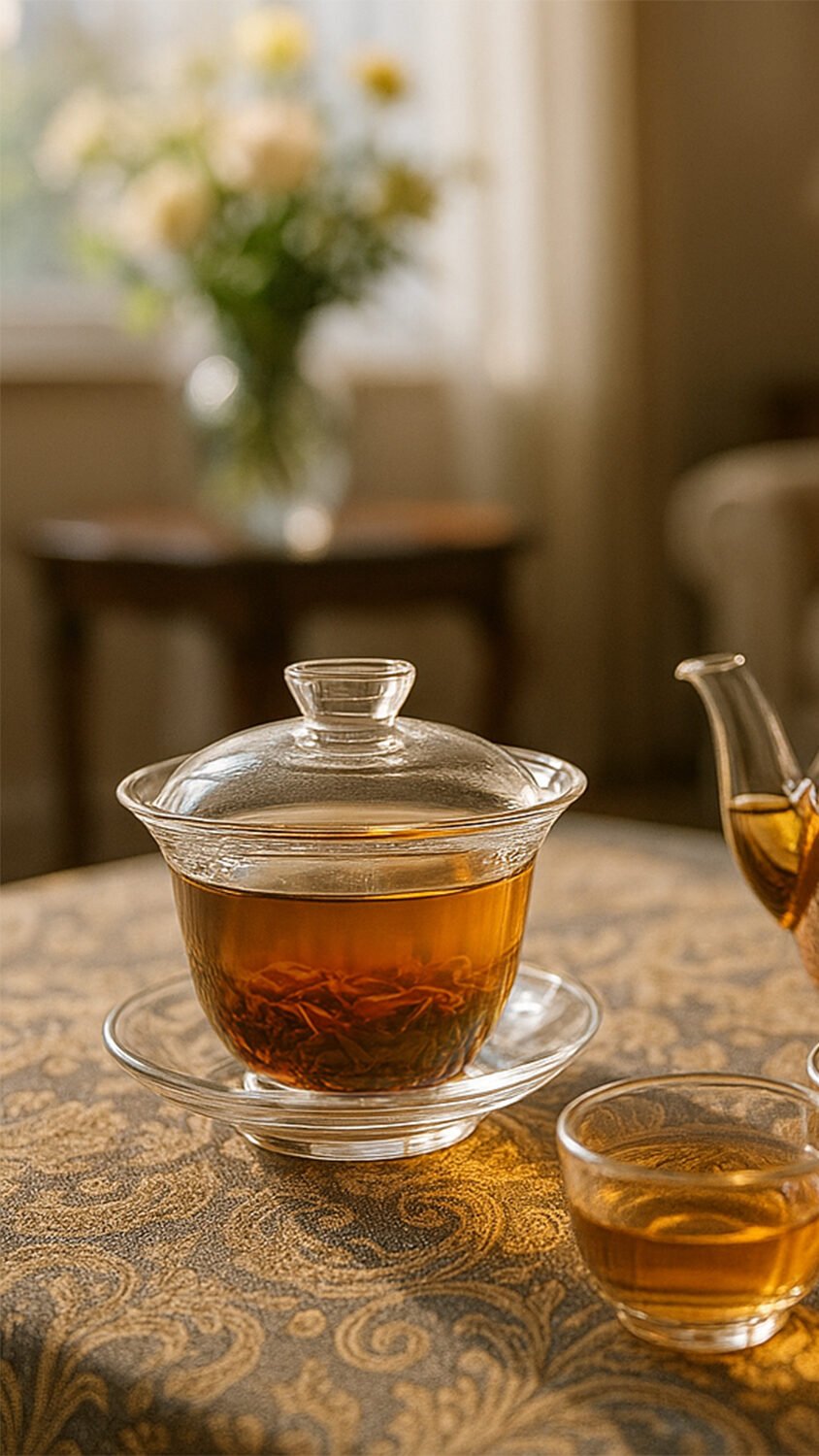
- Oolong’s heat requirements – These complex leaves thrive in porcelain or clay gaiwans with excellent heat retention. Fill only halfway despite their bulky appearance – oolongs need room to unfurl completely.
- Black teas and steady warmth – Thick-walled porcelain gaiwans maintain the consistent heat black teas require. The lid traps those rich malty aromas that define quality black tea experiences.
- Puerh and Yixing clay – Aged puerh teas pair beautifully with Yixing clay gaiwans. The high firing temperatures used in creating these vessels complement and enhance puerh’s distinctive earthy depth.
Special Brewing Considerations
- Herbal infusions need extra heat – Hand-thrown ceramic gaiwans with thicker walls keep water hot enough to extract full flavor from herbs and fruits. Heat retention becomes crucial for these non-tea botanicals.
- Scented teas require space – Jasmine and other scented teas benefit from gaiwans with wider openings. This design allows floral aromas to develop fully while you control steep time precisely using the lid.
The next section explores how gaiwans serve as essential tools for both beginners and experts in assessing tea quality and discovering subtle flavor nuances.
Gaiwans for Tea Exploration and Development
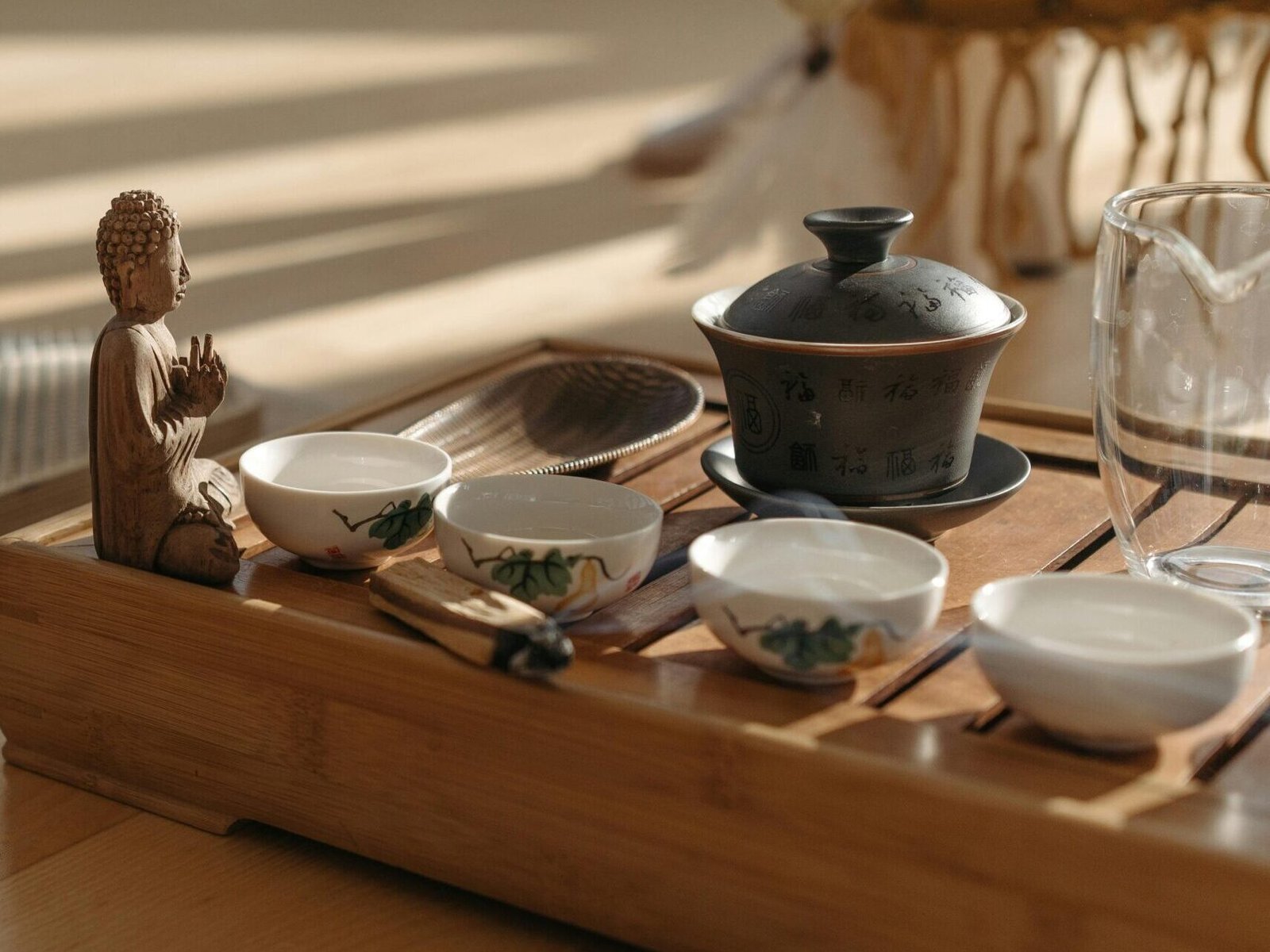
A gaiwan helps you learn the full range of tea flavors by letting you see, smell, and taste each steep clearly. Beginners and experts alike value this simple brewing vessel for its ability to reveal subtle differences between tea grades and processing methods.
Suitability for Beginners and Experienced Tasters
Gaiwans offer an ideal starting point for beginners exploring gongfu-style brewing. Travel sets that include a gaiwan make this traditional brewing method more accessible to newcomers who might feel overwhelmed by complex teaware options.
The simple three-part design teaches fundamental brewing skills while allowing new tea drinkers to observe leaf expansion and color changes directly. Brands like Yi Xuan create stunning gaiwans with carrying cases perfect for tea students on the go.
Experienced tea tasters benefit equally from this essential brewing vessel. The white porcelain cups and gaiwan sets provide a neutral backdrop that showcases true tea characteristics without altering flavors.
Master tasters appreciate how gaiwans reveal subtle notes in different kinds of tea through direct observation and precise brewing control. The lovely gaiwan serves both as a practical tool and an expression of tea culture, with hand-painted designs that honor traditions dating back to the Yuan dynasty.
Assessing Tea Quality and Nuances
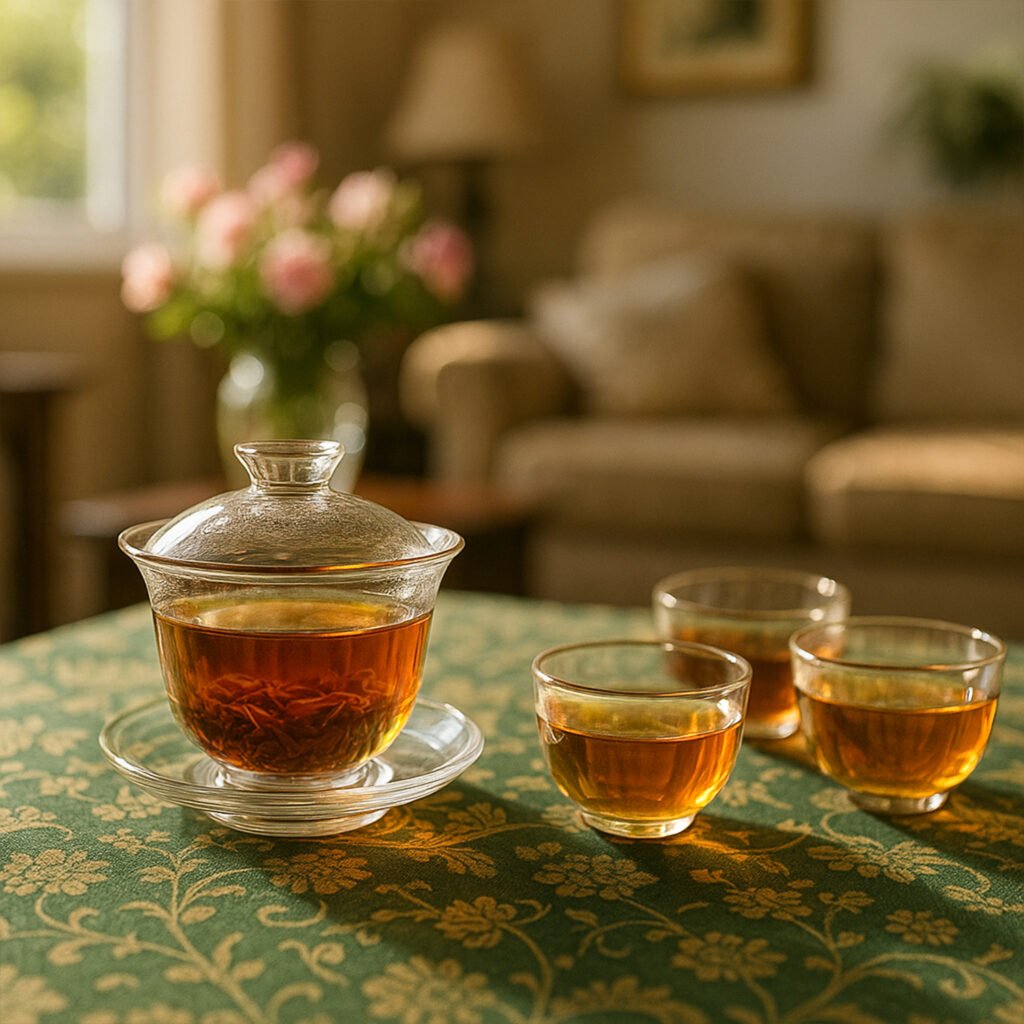
A gaiwan serves as the perfect tool for serious tea assessment. Its white porcelain surface creates an ideal backdrop to examine tea leaf color, unfurling patterns, and liquor clarity.
You’ll notice subtle flavor shifts between steepings that might go undetected in larger brewing vessels. The gaiwan’s neutral material, especially de hua porcelain, doesn’t alter tea flavors, letting you taste each note exactly as intended.
Many tea experts prefer gaiwans made from glazed ceramic for evaluating different kinds of tea because they don’t retain flavors between sessions.
Tea quality evaluation becomes more precise with a gaiwan’s controlled brewing environment. The lid traps essential aromatic compounds while allowing you to smell the tea’s fragrance with each pour.
This brewing method highlights defects or exceptional qualities in your leaves. The bowl shape lets you observe how leaves dance and expand during steeping, revealing processing quality.
A white gaiwan specifically helps you judge the tea liquor’s true color against a neutral background, making it easier to spot variations in oxidation levels or processing techniques that affect both taste and appearance.
Conclusion
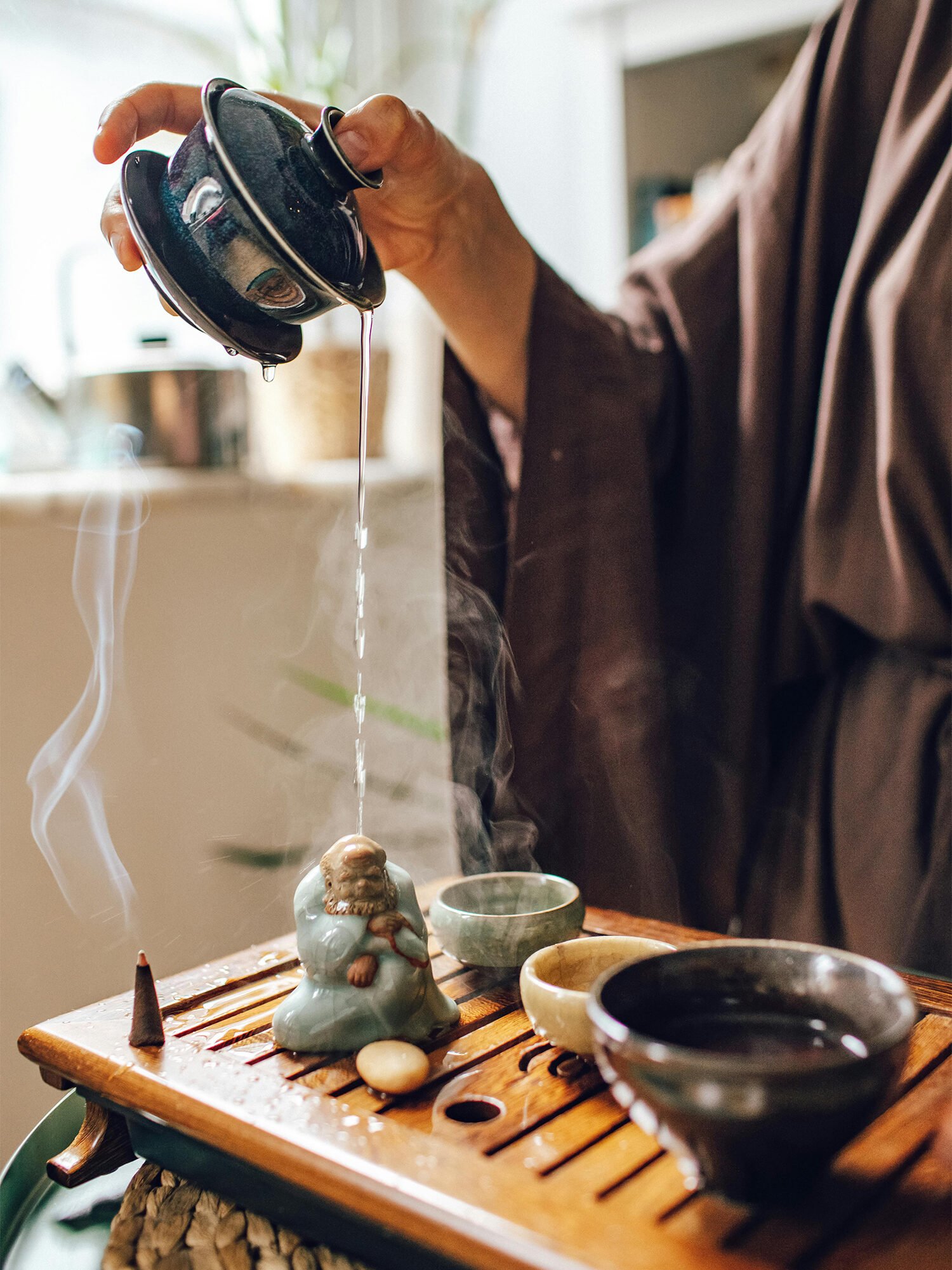
Selecting the right gaiwan transforms your tea ritual from simple brewing to an art form. Each vessel brings unique qualities through its material, shape, and craftsmanship. Porcelain offers purity of flavor while clay adds subtle depth to your favorite teas.
Your perfect match depends on what you value most: heat retention, pouring control, or visual appeal. With time and practice, handling techniques improve, so start with a basic porcelain gaiwan before exploring specialty options.
The experience with your chosen gaiwan will deepen your connection to tea traditions while revealing new dimensions in every cup you brew.
FAQs
1. What is a gaiwan and how do I use it to brew tea?
A gaiwan is a traditional Chinese tea bowl with a lid and saucer. To use a gaiwan, place tea leaves in the bowl, add hot water, and let it steep. The lid helps trap the aroma while brewing and can be used to strain the tea when pouring.
2. What materials are gaiwans made from?
Gaiwans are made from various materials including porcelain, ceramic, and Yixing clay. Porcelain gaiwans are most common and highlight the color of tea, while gaiwans made from Yixing clay can enhance certain flavors. Some feature beautiful hand-painted designs with colors like pink and orange.
3. Can I travel with my gaiwan?
Yes, travel tea sets including a gaiwan are available for tea lovers on the go. These portable sets often include tea cups and essential tea tools in a compact design. They’re perfect for enjoying your kind of tea anywhere.
4. How does kiln firing affect a gaiwan?
The kiln process greatly impacts a gaiwan’s quality and appearance. Different firing methods create various ceramic glazes and finishes. Traditional kilns in China produce distinctive styles like Jian ware, which tea enthusiasts prize for their unique properties.
5. Which gaiwan is best for different types of tea?
The perfect gaiwan depends on what tea you brew. Porcelain works well for delicate teas where you want to appreciate the color. Yixing clay gaiwans enhance the aroma of oolong teas. For beginners, an all-purpose porcelain gaiwan is inspired by centuries of tea tradition and works with most teas.

